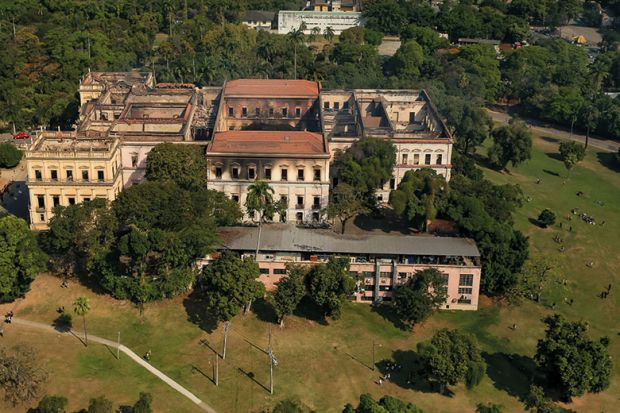On Sunday night, I watched as the National Museum of Brazil burned to the ground. On Twitter and in WhatsApp messages, friends and “followers” shared live footage of flames consuming the 200-year-old imperial residency-turned-national museum and archive.
After the six-hour blaze, the images of the hollowed-out building, with only a meteorite still intact among the estimated 20 million artefacts and documents lost in what many claim was a preventable fire, echoed the indignant sobs, choked with ash, of all those people who had some connection to the museum.
Those of us in the post- and decolonial humanities and social sciences have become critical of museums. Informed by artistic practices such as Fred Wilson’s exhibition Mining the Museum and Guillermo Gómez-Peña and Coco Fusco’s performance piece Couple in a Cage – both of which opened in 1992, the 500th anniversary of Columbus’ villainous voyage – we have come to see museums as reproducers, if not co-conspirators, of systems of colonial, patriarchal, racial and class oppression.
Museums are the quintessential symbol of modernity through their framing of a barbaric past – usually the result of the othering of non-white peoples and the plundering of cultural artefacts – and promise of future progress through scientific enquiry.
At first glance, the National Museum of Brazil had all the trappings of a museum as a modern institution of national identity formation. It was housed in the former palace of the Portuguese court in extensive grounds now known as Quinta da Boa Vista Park.
It contained Latin America’s largest collection of ancient Egyptian artefacts thanks to Emperor Dom Pedro II’s ambitions to keep up with the Joneses of 19th-century Europe by personally collecting pieces related to the emerging fields of archaeology, anthropology and palaeontology – all fields, like the Portuguese and Brazilian empires themselves, that were forged through the colonial theft of resources, knowledge and life.
But it was also this imperial past that would make the museum one of the few easily accessible cultural and historical institutions in Rio de Janeiro. As the Brazilian monarchy gave way to the republic and Rio’s elite moved south along the city’s coast to places such as Copacabana beach, Quinta da Boa Vista and the museum became part of the North Zone, the subúrbio. “Periphery” is a more fitting translation for the Portuguese meaning of this word than “suburb”, since the subúrbio is home to Brazil’s racially and economically marginalised brown and black working-class.
As the premier museum of national patrimony in this part of the city, the museum embodied access to scientific learning and higher education long before socio-economic and racial quotas in federal universities were ratified into law in 2012.
A short train or metro ride away many of the city’s working-class neighbourhoods and with admission costing less than R2 (£0.38), the museum was accessible in the most fundamental way: it was nearby and it was affordable.
For the mostly black and brown low-income residents of Rio’s North Zone, a school field trip or a family picnic in the park followed by a visit to the museum’s dinosaur collection was the first time that they set foot in a museum. Young people whose parents had never attended university could see the work of anthropologists, historians, geologists and other scientists. And no matter our thoughts about the role of museums in constructing national and lingering colonial identities, dinosaurs are just objectively cool.
We can lament the ways in which museums produce certain forms of knowledge and understandings of what counts as history and culture, and what counts as, well, peripheral. The very process of collecting documents and artefacts silences the objects that do not make it into the archive.
But neglect also silences. What was, until Sunday night, the largest collection of indigenous texts and recordings of languages with few or no living speakers in Latin America has been lost forever.
Many people feel that the disregard of successive federal governments that destroyed the National Museum of Brazil will continue to deprive residents of the subúrbio of education and culture. Especially so in light of a constitutional amendment, passed under President Michel Temer’s administration, that freezes spending on health and education in Brazil for the next 20 years.
The destruction of the National Museum has meant that the subúrbio, the periphery, has lost a place that made it a centre – a centre of research and learning not only in Rio, or Brazil, or Latin America, but the world.
Stephanie Reist is a dual MPP-PhD student in Latin American Studies in the department of Romance studies at Duke University.
